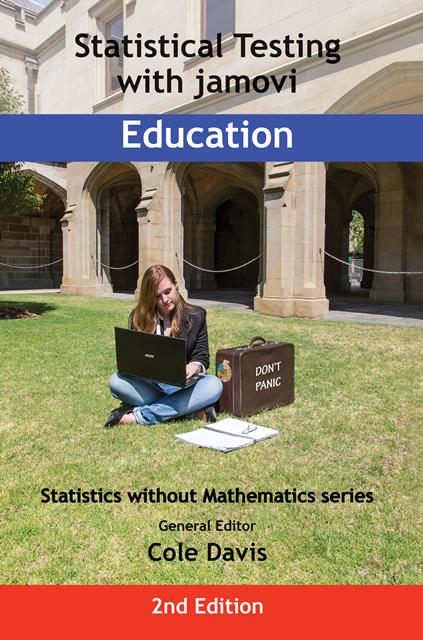|
| Home |
| Order books |

|
Statistical Testing with jamovi for Education
Statistical Testing with jamovi for Education
Exercises and case studies
Chapter 8 in the book contains basic exercises covering all of Section 2. Diverse tutors, however, have asked for traditional chapter by chapter exercises, hence the table immediately below. Further down the page, case studies are presented for readers who have finished reading the whole book, or their tutors.Exercises
These chapter by chapter exercises have been contributed by Marianne Vitug. For each chapter is a document with the questions, and one with the answers, with relevant spreadsheet files (with the .csv suffix). Each page opens in a new tab of your browser.
| Ch 2 Research design | Questions | Answer | self-entry |
| Ch 3 Descriptive statistics | Questions | Answers | data file 0 |
| Ch 4 Null hypothesis significance testing | Questions | Answers | data file 0 |
| Ch 5 Tests of differences | Questions | Answers | data file 1 |
| Ch 5 Tests of differences | data file 2 | ||
| Ch 5 Tests of differences | data file 3 | ||
| Ch 5 Tests of differences | data file 4 | ||
| Ch 6 Tests of relationships | Questions | Answers | data file |
| Ch 7 Categorical analyses | Questions | Answers | data file |
| Ch 10 Factorial ANOVA | Questions | Answers | data file 1 |
| Ch 10 Factorial ANOVA | data file 2 | ||
| Ch 10 Factorial ANOVA | data file 3 | ||
| Ch 11 ANCOVA | Questions | Answers | data file |
| Ch 12 MANOVA | Questions | Answers | data file |
| Ch 13 PCA and factor analysis | Questions | Answers | data file 1 |
| Ch 13 PCA and factor analysis | data file 2 | ||
| Ch 14 Logistic regression | Questions | Answers | data file |
| Ch 15 Partial correlations | Questions | Answers | data file |
| Ch 17 Bayesian statistics | Questions | Answers | data file |
| Ch 18 Survival analysis (Kaplan-Meier) | Questions | Answers | data file |
| Ch 19 Cluster analysis | Questions | Answers | data file |
Case studies
You have a selection of different measures derived from studies of bullying at school. Are there different types of bully?
Looking at a battery of results from different educational tests, you wish to see if a particular model is especially robust.
Do immigrant students who are awaiting asylum decisions have different educational results profiles compared to those with refugee status? You believe that age, ethnicity and gender may also affect the classification.
Is a type of teaching method likely to differ in its effectiveness depending on the type of educational setting? For example, if we used inquiry-based learning, would it have very different effects on students in prisons, universities and schools? Age, ethnicity and gender may affect the classification.
You are interested in the willingness of students to participate in sports. Which psychological attributes tend to be associated with keen, apathetic and hostile attitudes? You may wish to consider attributes such as the number of fellow students with similar attitudes, the age and gender of the respondents.
Kidd and Castano (2013) found that reading novels, as opposed to popular fiction, non-fiction and nothing at all, improved empathy, as represented by Theory of Mind skill. You want to try this design out with young people with behavioural problems and see it has an effect on social skills, attitudes and behaviour.
You are interested in how long it takes children in care to be provided with mainstream education. Are there differences between age groups, or ethnicity, or behavioural problems, or whether or not children have been sexually abused?
Three groups of children with learning disabilities each attend different types of reading class. One group receives a phonics method, another primarily 'whole word' reading and a third a mixed model of teaching. Are there significant differences in test results and is there a difference between male and female students?
Each year, over three years, a different classroom control technique is used with students with conduct disorders. Each method is used in three different types of educational setting. By the end of the period, each setting would have experienced all of the methods.
Students in a state's police academy have over the years found certain statutes on domestic violence to be very difficult to understand. Over the year, two sessions with somewhat different teaching methods are tried: one focuses mostly upon case studies, while one pays more attention to the legal principles involved. The sessions are in fact held four times, so that half the students get to use the case studies first while the other half do legal underpinnings first, each attending the other session later.
Are there particular types of student who drop out of university?
(Assume that there is no knowledge of the topic.)
Statistics without Mathematics series - General Editor: Cole Davis
ISBN numbers: Hardback - 978-1-915500-09-0 Paperback - 978-1-915500-10-6 Ebook - 978-1-915500-11-3
